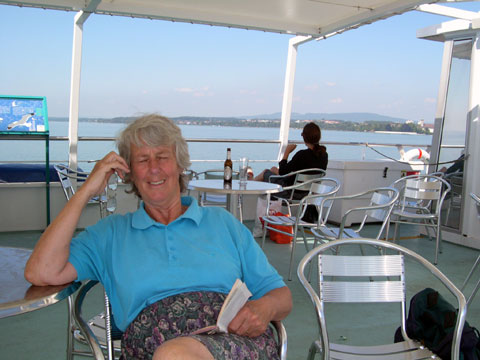Walking Through Germany


We had finished our walk from Switzerland to England and it had been such fun, it seemed a good idea to do something similar.
We can both speak German, the country is next to CH, we mostly knew negative things about it - the two wars. It would be an idea to walk through it and see what it was really like?
Where? From the south 'coast', i.e.Bodensee, to the Baltic. The first part would be through the part we didn't really know, that is up the east side of the 'Land' of Baden-Württemberg, (which has the better known Black Forest on its west side and on its east side Bavaria,, generally well-known for its Alps.
We got the Lonely Planet Guide and the two relevant 'Bild Atlas' and various bits of information off the Internet, including an outline of the Haupt Wanderweg 4 (HW4 - Bodensee - Donau - Main) starting at Friedrichshafen and going up to Wurzburg and which looked right for us. The outline included a list of the hotels and guesthouses, plus their addresses and phone numbers, available in various of the towns and villages on the way. We found later that the DBB leaflets also gave lots of information about places to visit - to encourage people to take advantage of their special fares.
There are lots of walking guides etc to Germany but for the HW 4 anyway, no Topoguide such as you have in France etc. Hector had been to Friedrichshafen and picked up the BODO train and bus timetable which would also cover the first two or three days. We hadn't yet got the feel of a German map so we did not know what distances we would be able to cover or if it might be nice to stop before we actually got to our planned destination for the day - perhaps we'd been too ambitious. Then we'd need a bus or train to a place with a hotel.... We bought the first two 1.50,000 maps which showed the first 3 or 4 days of the HW4, packed as little as possible BUT including Dombey and Son, Plant and Planet by Huxley, sodukus (latest rage) Ladygrams. It was a weekend and the German hols so we booked the first two guesthouses over the phone (two nights in Tettnang and one in Waldburg ). We did not know how it would all pan out as regards the quality of the path etc etc....but we'd give it all a try for this holiday anyway.
N.B. 'tar' includes that in built-up areas.
The general impression from the maps - we don't have single one like the French Serie Verte for the whole area - is of lots of green areas (forests), reasonably widely spaced contour lines and villages dotted around. There are also quite a lot of patches of short blue lines indicating swampy bits.
Some history which might be relevant: Germany was once a mish-mash of monasteries, cities, principalities, knightly domains etc until Napoleon rationalised (and secularised) a lot of things and then Germany later became one country. Every now and then some German, because he/she has retained his/her title appears in Hello Magazine or the like. The Württemberg family were in turn counts, dukes, electors, kings and then dukes. In 1866 they allied with Austria against Prussia, lost and had to help Prussia against France in 1871. They did not want to join the German Empire as they saw it as essentially Prussian.
There is a current duke, Duke Karl, married to Princess Diane d'Orleans. It is clear from the Christian names of various members of the family that they are RC - but perhaps not???. But in fact Württemberg 'officially' followed Luther in 1534. Baden remained RC.
An overview: Bodensee to Setzingen (just north of Ulm) 26 Aug to 7 September 2005. And the weather does not need to be mentioned because the whole time (after a slightly dicey summer and then the rain and flooding) it was HOT and cloudless. The best thing was to walk in the cooler morning hours and then try to arrive soon after two or before, indeed, because the p-ms were not pleasant. But as always if you were in forest, it was that much better.. This we managed most days. - so individual times of arrivals not given.
This walk was just after there was a lot of rain in the Alps and lower down, so that Bern and other places round Bern and places in Bavaria (those fed by Alpine rather than Black Forest rivers) experienced widespread flooding.
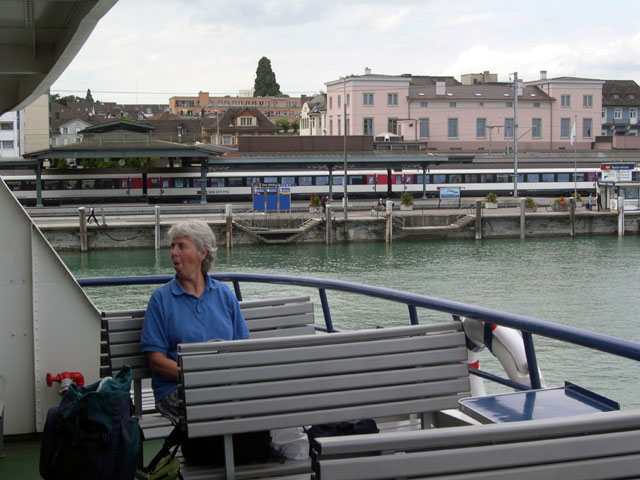
We took the 11.02 from Bern, Romanshorn 13.15, connecting ferry to Friedrichshafen took 40 minutes. Hazy Austrian and Swiss mountains in the distance, a water jet ahead, the red-tiled roofs and white-washed walls of the houses in Friedrichshafen (and as they did everywhere) standing out ahead of us.


The footpath signpost said Tettnang was only 11 kms so instead of getting the bus there and coming back the next day too do it as originally planned, we set off there and then. We first went through the lakeside nature reserve where there was lots of those unwanted incomers - golden rod and Himalayan balsam. A series of boards told us about the flora and fauna and that one day - a long time ahead - the lake would be totally silted up by the contents of the rivers coming down from the Alps. The walk was well-marked, as it would always be, with little red and white plastic signs - our path is a red oblong on a white field,others are a triangle, or circle or a square for there are several long distance paths - on the trees etc. There are frequent yellow fingerposts giving the distance in kms. Then through a wood, an area of espaliered apple orchards, a whole field of late strawberries ( somewhat tasteless) and then numerous hop fields, the poles being 4 metres tall and covered in hop bines and hops. We were not yet used to the maps and had not realised that what to us looked like roads were farm tracks, a pleasant surprise.


There was one roofed wooden bridge. A notice on it said the Gemeindes on each side has quarrelled as to who should repair it, so the King of Wurttemburg with the wisdom of Solomon combined the two Gemeindes and gave them 4 hectares of woodland to grow trees for the repairs.
As you approach Tettnang, on a hill, the first thing you see an enormous building which the map called a Schloss, once the home of the Dukes of Montfort - and to English eyes more like an enormous stately home. Then there was a memorial to the 1870-1 war.


The centre of little Tettnang had pavement cafes, and pretty white-washed steep-roofed houses with stepped gables. We booked in at the Trauben Gasthof. We've both got a bit of a list like boats whose cargo has shifted, but the fiesty grandma was older, She bustled up to shake hands and show us our room. When we strolled round later, there was a delicious smell of hops in the air, which we traced to a shed where a load of hop bines was being hooked onto a conveyer belt to be shredded.

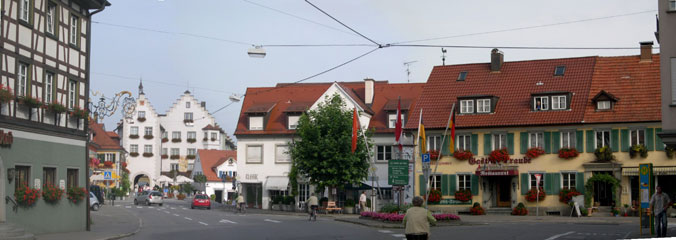
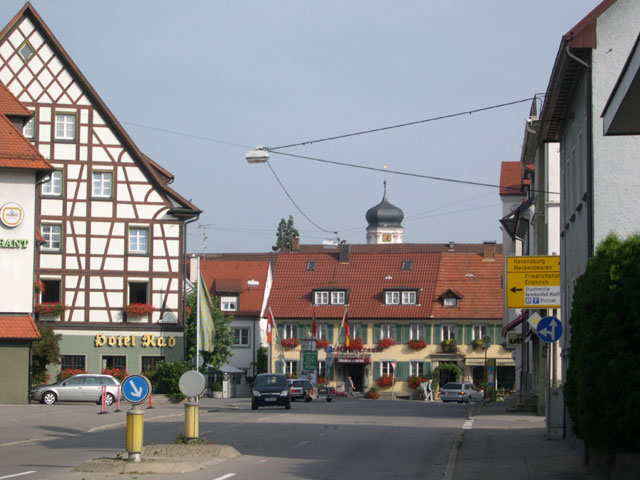


Tettnang belonged in turn (depending on the politics of the day) to the Duke of Montfort, Austria, Bavaria, Wurtemburg and then Baden-Wurtemburg.
Supper in the courtyard. We watched a coach disgorge tourists at 8 p.m. at the hotel opposite..
The coach people were gone soon after 8. We had a day in hand and couldn't do any of the next day's stretch, a somewhat long one, because there was no means of getting back - it being a Saturday and few buses. Bought a day ticket on the transport network and did the 'Leinwand' town of Ravensburg, charming but overcrowded and a band making a din in the central square - they were Red Indians in full regalia. I fear that the obtaining of the feathers for their head dresses must have been the cause of death of many beautiful birds, but who are we to talk? Various buildings had info boards on them, the Jews were driven out (the first time) in 1429. There was to be a General Election soon so everywhere here and elsewhere there were boards up showing Angela Merkel and Schroeder with his black non-dyed hair. (He won a law-suit against a paper which said wrongly and wickedly it was dyed, which is how we know it's dyed, well touched up.) They are the main contenders for the Chancellor job (lots of money, tied house and company car) but there were also portraits of the various local candidates.
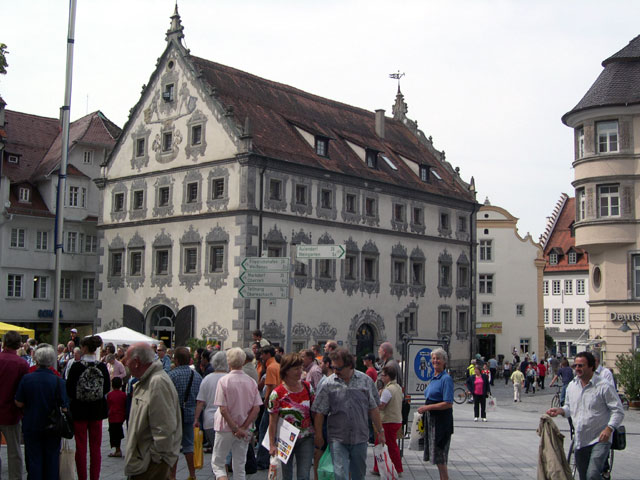
Took train to Friedrichshafen and another train and bus to Salem Castle - ex-monastery (thanks to Napoleon) and the boarding school founded by Kurt Hahn - it would appear that now all the parents need is lots and lots of money. I don't know when Hahn's ideals went out of the window. We had the guided tour - the church is very baroque i.e. ornate (Counter-Reformation). Without the tour we would not have seen much.


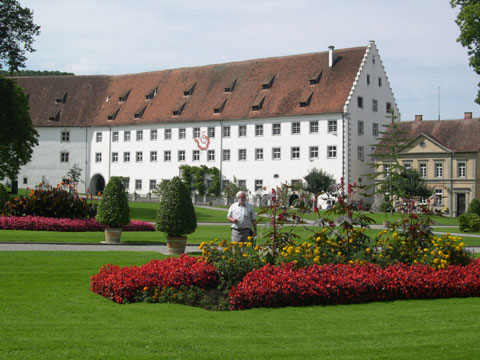

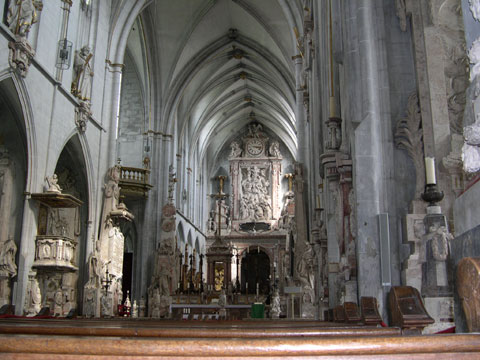
A Kännchen Tee and Stück Torte at a caff and then back to Tettnang. Lovely lush countryside - saw one proper Tierli (Cornelian cherry), a tree the size of an apple tree (I think of them more as shrubs), a huge walnut and a huge spindle.
On the wall opposite our bedroom door where we saw it every time we went in and out was a prayer, "Dear God, Do not let me open my mouth until I am sure I know what I an talking about." There was a huge plane tree with a bench round it outside the Trauben (our hotel) where it was pleasant to sit and watch the world go by. Had supper later in the little courtyard - pork - on lacy mauve plastic table cloths but more than made up for when Grandpa came round to say good evening and see all was well. Another coach party of tired (I imagine) holiday-makers arrived at 8 at the hotel opposite. After supper it was still too early for bed so on that balmy evening we strolled round the little town past cafes and small children calling and playing in the square like a flock of sparrows.
The coach and contents was gone by 8.15 - the holiday makers have to work hard.Madame always waves them off. She must be glad to have guests who leave so promptly.
We shook hands with grandma and walked past more hop fields and espaliered apples and pears - you could see the bulge at the bottom of the trunks where the young tree had been grafted on. Some were so heavy with fruit they'd fallen over. We could have eaten ourselves silly on blackberries, windfall apples, pears and, once, plums. Various slugs on the path, all going north it seemed and suicidal (at which stage as they melt while they go round and round - you can follow their slimy tracks - are they brain dead?) in that weather, some of them bright orange - a good logo for easyJet??
Acc. to the map we were also on the Bodenseejubilaumsweg. For the first stretch we were mostly on little roads but here as elsewhere when this happened, I have to say there were no cars - they were sort of tarred farm tracks: EC money or tarred to get rid of surplus profit and not pay tax? We left the road to climb up steps through a wood - the birds silent except for the odd yaffle and always buzzards mewing - to a chapel, a viewpoint, a strong smell of hops and the sound of a hop shredder.
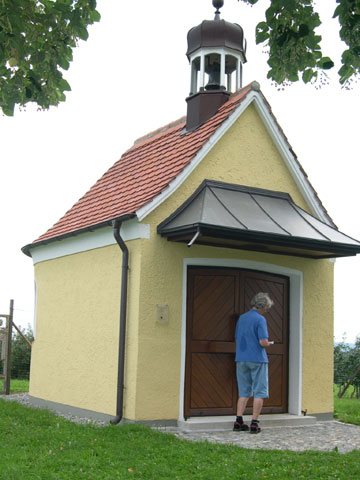
The chapel, built in 1953, was beautifully kept and dedicated to 'Mary the Queen of Peace' because of the 'unselig Weltkrieg'. This must be a RC enclave because today as opposed to the walk from Bodensee to Tettnang, we passed several shrines - which is somehow what I associate with Germany I suppose we had mostly been in Bavaria which was and is very catholic, so much so that private houses have a shrine sometimes in the corner of the living room. (Württemberg was converted to Xianity in the seventh century by Irish monks. After Luther started things off, it was a case of cuius regio, eius religio - and the area before Germany became one country had any number of different princes, margraves, dukes,...a title had always been - and is - a good and cheap way to reward someone. Think of Mary of Teck.,)
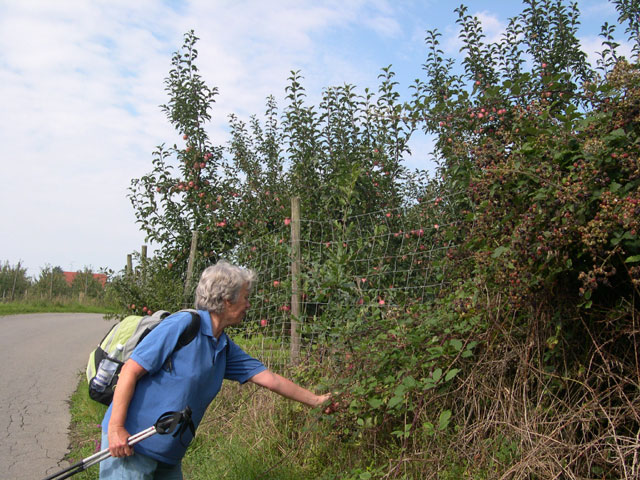
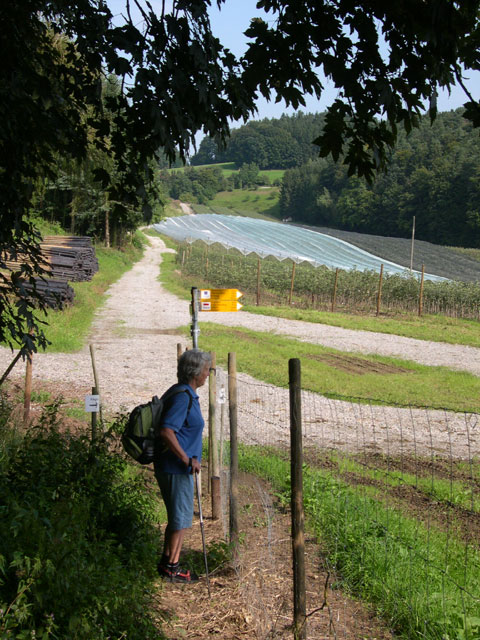

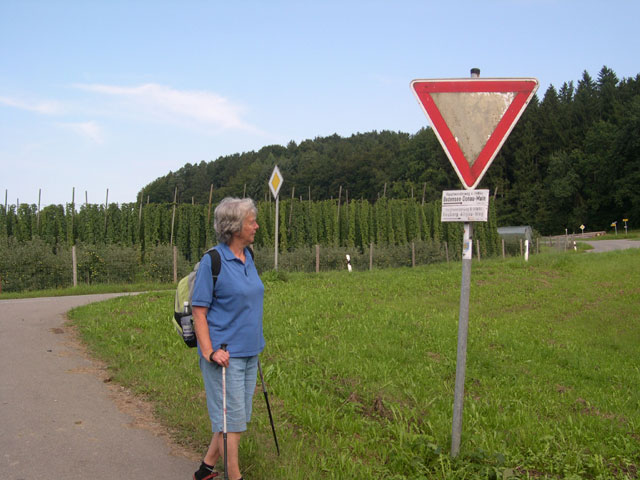
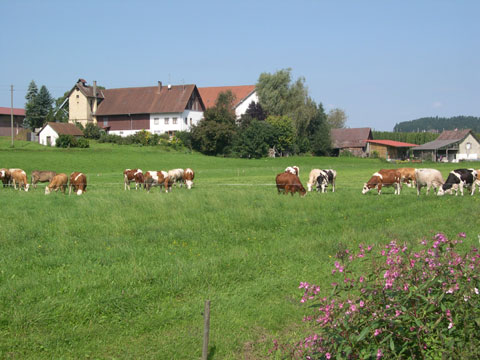
The next hamlet had the lovely name of Herrgottsweiler. Soon after that we passed a stall decorated with hops and selling local fruit and then came to a farm with tables and chairs and selling drinks on Sundays but two carloads of noisy old people had just arrived. Then we went into a wood as suddenly as if we'd gone through a door and under the tall trees it was blessedly cool and dark - no bad thing in that hot weather.
We'd promised ourselves a drink at Bodnegg at the hotel that had said it was full when we'd rung from Bern to book in there. We sat down outside but nothing happened so we went inside. There was a brunch in full swing with a Polish quartet, the violinist was going round playing in peoples' ears and leering at them. We'd got plenty of nibbles, were glad we couldn't stay there and went to the nearby baroque church (with ceiling frescoes), on top of a drumlin, and sat under trees with a view over the surrounding countryside and ate our various nibbles. There was a war memorial to the local fallen 'heroes' of both wars. We filled up the bottles at the water tap in the graveyard - we were only carrying half a litre each and that was not enough. I tried not to drink too much as the water tasted of dead bodies and luckily we were mostly in a forest - at one point there was a group of shaggy caps looking like a collection of modern traffic bollards..
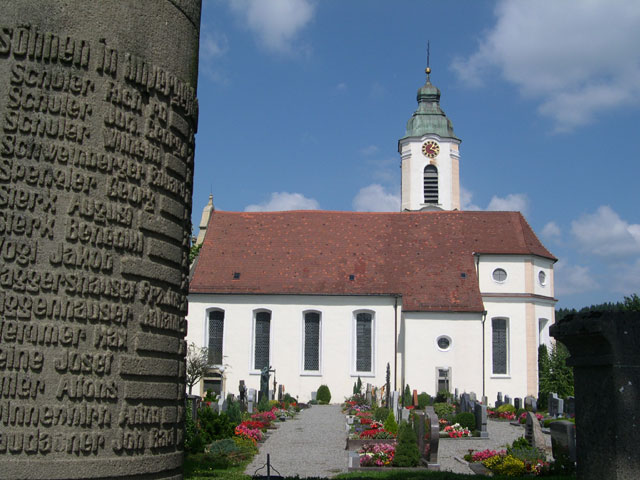


As we approached Waldburg (stuffed with people as the annual ceramic market was taking place), the Burg rose up in front of us above the trees as if it was floating.

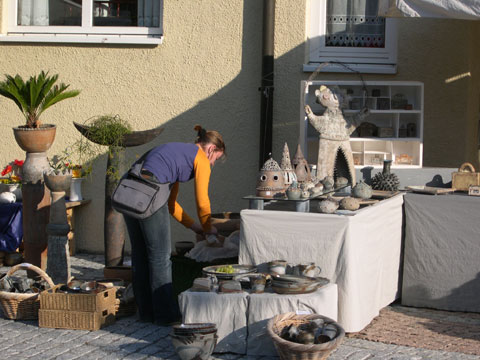
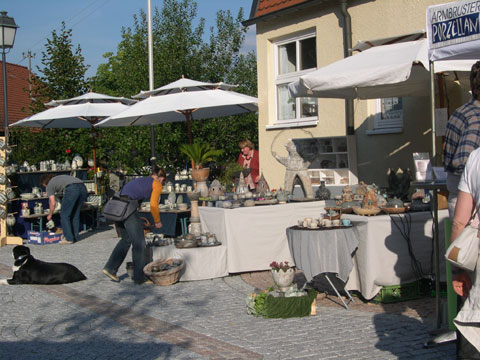
We found the hotel we'd booked into - not so difficult in such a small place. It was built in steps on the side of a hill, shook hands with madame and went downstairs to our bedroom.
After a siesta, we laboured up steep hill to the Schloss just above us but it had closed at 5 and was closed on Mondays (the next day) - this happened quite a lot with local sights or places even if it was a day to be open had limited opening times. Madame lent us a leaflet about the Schloss - it had been given by Francis 11 (who he?) in 1803 to the Waldburg family. There wasn't much view from the top of the hill because of trees and general heat-haziness.
We had supper on the terrace when it was cooler. A huge handsome tabby cat wandered around, jumped up on the wall, jumped off and went into the lane, came back and was altogether hyper-active or so it seemed, appearing from quite different directions very quickly - but then I looked down, having had just an Apfelschorle (apple juice with fizzy water) to drink - and there were two handsome huge cats... "They come from just down the road and adopted us," Madame said, "when their owners moved house and the new owners didn't really like them...."
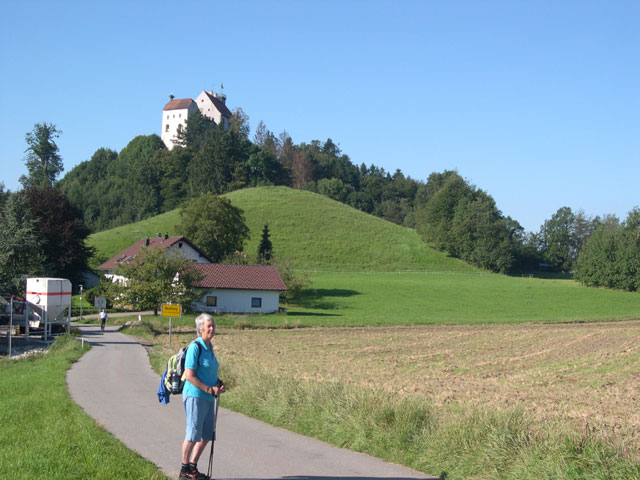
Waldburg is called a 'staadliches Erholungsort', although we weren't sure why - but it is 650 m above sea level. As we left from the back of the village, the castle on its hill was most impressive. Nearby was another drumlin with a picnic tables and tree on top. Behind that was the Bodensee and Alpine panorama shimmering in the haze. The grass everywhere was laden with dew. The hops and fruit trees were finished and we were mostly in a forest of firs and as with the previous days, met no one except some mushrooms gatherers - one indeed one saw our Finefare bag bulging with what she thought were mushrooms (but in fact the picnic) and asked if we'd had success with mushrooms.

The way - the land is gently undulating - took us past one of the large patches of boggy ground shown on the map, although from a distance it looked like a stretch of normal scrubland. There was another long stretch of forest and a row of bird boxes like a suburban street. We had to be careful with the route finding as it was easy to miss a turning and just drift on along the obvious path. The pretty yellow fingerposts that we'd had round touristy Bodensee had long since disappeared - we rarely found anything giving the distance and mostly had to calculate it ourselves from the map.
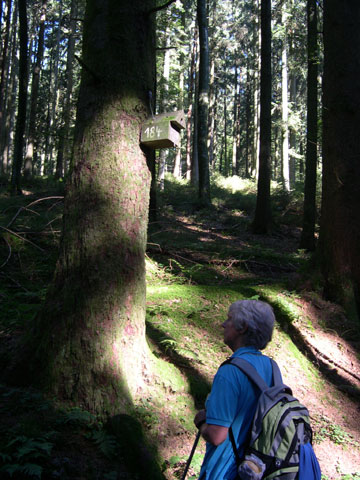
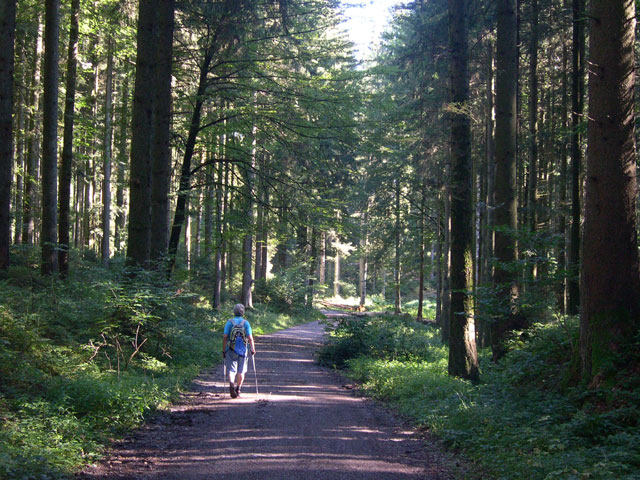
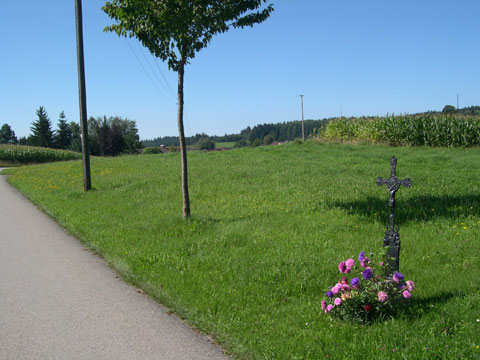


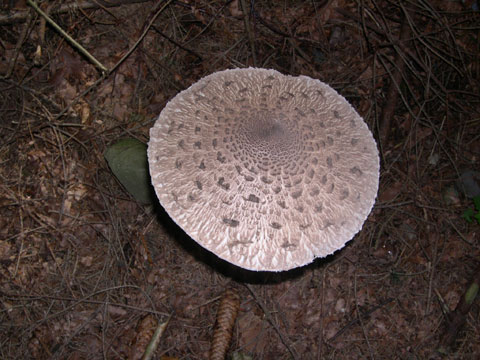
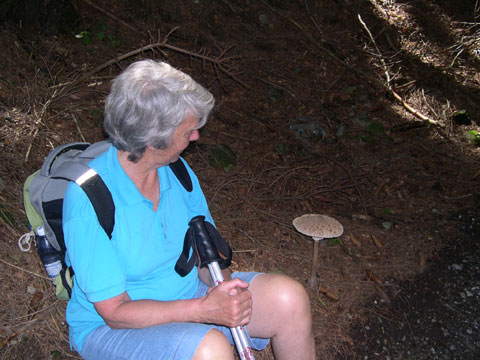
We were heading for Wolfberg - once the name of another local family. A group of lady cyclists asked us to take their photo and one offered to take my rucksack. Wolfburg eventually came into view above us on a hill with the usual monastery standing out - and which the DB leaflet said was worth seeing.
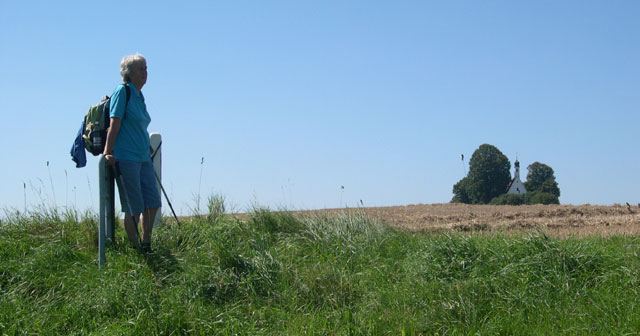
But after touching the most far-flung houses, the path to the isolated station where we intended to pick up a train to Bad Waldsee - two stops down the line and too far for to get to in one day, especially in such hot weather - took us in what seemed like an endless circle through the fields round it - a farmer was having a screaming match with his son - and we never did see the main street. There was an hour to wait for the train but the nearby nice looking little inn with a terrace and umbrellas was closed, a notice said 'due to illness'. . and we had run out of water. But we spent the time pleasantly enough in a shady clearing in the forest.

We looked at our list of accommodation and the map of the town and decided on one called Gasthof Paradies , described in the Tourist Guide as gemütlich-rustical mit Biergarten and several hundred metres along the main road. It turned out to be very simple - there was too much lino and everything was in need of a coast of paint and the plastic flowers needed washing and mending but mine host, rotund, not young, had a most delightful grin. Because of good public transport, we'd be spending the next three nights there and therefore carrying nothing much but water. Of course we had to climb up to our bedroom on the second floor, but we had it ourselves and there was a boar skin on the wall outside our room and plastic flowers of paradise - the last one was a real one given to Antonia with a flourish by a gardener in the park in Redcliffe just north of Brisbane....

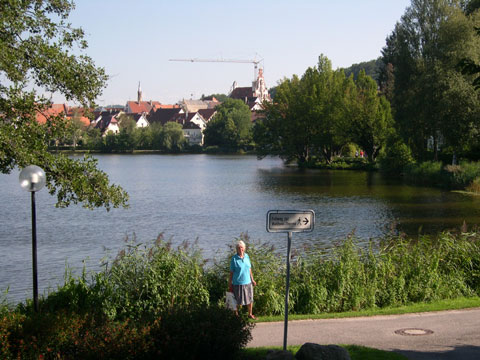

After a siesta we walked through a wood down to the lakes - the larger one had swimmers and sailing boats - and the old town which is totally traffic free and quite delightful - no wonder there is a huge car park on the edge of the town. Bad Waldsee is a Kurort with the hottest springs in Oberschawen (65 degrees) coming up from 1750 metres in the earth. At the moment there is the 'stork parade' with 40 two meter high storks being places round the town and each dressed differently acc. to where it is standing - the one outside the boutique had long eyelashes and a lovely hat, one was a Red Indian, a blue one outside the hot springs, one carrying 4 babies, one in armour....
The Burgersichekuche (cooked by mine host's wife but she lived in the kitchen and we never saw her) was what Paradise offered. We ate it outside next to the Stammtisch and next to the Bier Garten - which seemed to mean two wooden benches facing each other with a roof over them and the table in between covered in a blue check plastic cloth. It was the inevitable pork or wild boar and the same salad we have had everywhere - a mixture of various salad veg somewhat swamped in sauce.
It was mine host's free day and he had 'lots to do' so we had breakfast (in the bar which had several certificates on the wall honouring mine host's long service to the guest industry) at eight - a good time as it was so hot and was best to get going early and as there was a gap between our maps we were not quite sure how long the day would be. He checked we had our key and said a fond farewell. We had some food, one litre of water and one and a half of orange juice and a Xword should we have to wait for the train.(every two hours)..
There had been another heavy dew - at this time of year it takes time to evaporate - and the horizontal cobwebs on the grass in the park looked like filigree pocket handkerchiefs. We went through the old town and the old door on the far side and went into forest.
We reached the ruins of the castle of the former counts of Waldsee in the delightfully named Maulwurf Wood which had enormously high beeches. There was also belldonna, a huge beautiful pale brown toadstool and many blackberries - we never needed to buy fruit. The castle had been destroyed in 1683 by an earthquake. "Ripe for restoration," an estate agent would say. "Super position on side of hill with wide views.." - but planning permission probably ran out 4 centuries ago.
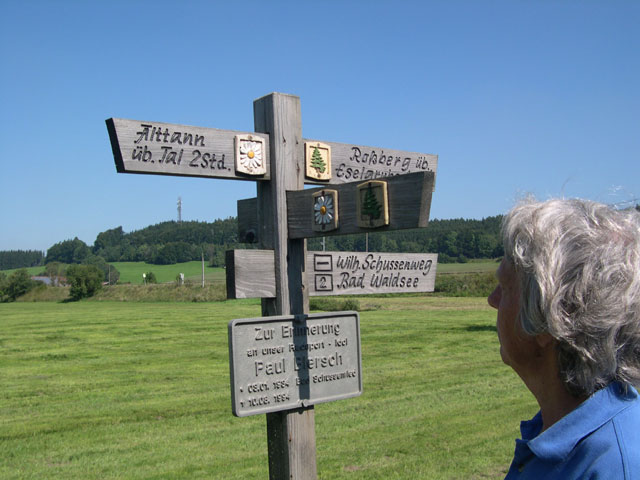
The hops and orchards had disappeared and out of the wood we were in pastureland and the constant smell of new mown hay as farmers got in their second (or third?) crop of hay.
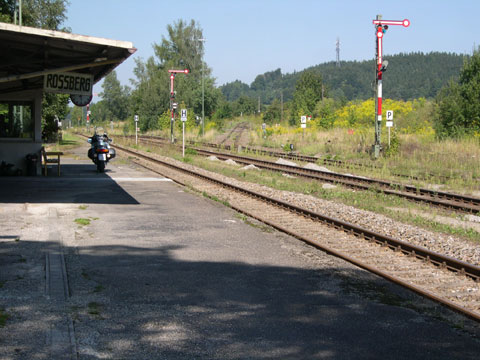

We picnicked in the bus shelter at Rossburg station - a BUS came but we waved it on. There was a choice of ways to our destination, each path being marked with a carved symbol - a daisy, bambi, maple leaf, fox The HW4 was another two hours along a river so we took the direct daisy way (one hour, near the railway line) although as we approached a gravel pit we knew we had gone wrong and had to navigate our way back to the railway line.... we had 20 mins to wait and there was a bench under a plane tree and a nice breeze.
We got back to Paradise at two (for a luverly siesta) and found mine host in residence and very sad, for his car had broken down. Later we strolled down to the old town to a pavement café for tea and map shop and watched a northern goddess giving a lesson in Nordic walking to a group of elderlies. Another menu elsewhere trying to be helpful said "What the Swabian eats..." and gave a list of suggestions - but it was mostly the usual pork.
The pedestrian traffic lights as elsewhere in Germany are fierce about us all obeying the lights - 'for the sake of the children'. There was one set outside the station at a busy intersection but whereas we grownups dutifully waited for the green light, a group of boys, aged about 10, dashed across when it was red plus a little old man with a stick and a green felt hat and a cockade as if he'd once been in the Jaeger Battalion and who perhaps was not quite with it - or young at heart.
Mine host was very sorry he couldn't give us fresh rolls but without a car he couldn't get to the bakery. The hearty brown bread was pleasant.
We first walked along what was surely once a little railway line and then crossed a golf course, past the club centre, once a farmhouse and with lots of people around. There were beautifully manicured greens and roughs raked to make a pattern. A kindly notice said, "Please don't tee off until walkers are out of the danger zone." I needed a sun hat but did not want to pay the club house prices for the honour of having a famous name on it.
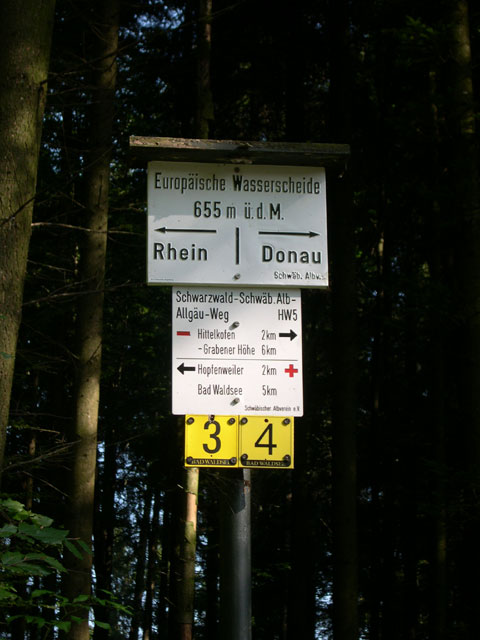
The path (now also the Schwarzwald - Schwabische Alb - Allgau Path) in the next wood went up a slight rise to 655 metres, the watershed between the Rhine (North Sea) and Donau (Danube - Black Sea) divide. It went past an anthill so big it was the equivalent of an anthill London. Naturalists say that trees and everything else round an anthill are especially healthy. I'd inadvertently disturbed an ants' nest, eggs and all when I'd idly picked the bark off the log where I was sitting waiting for the train the previous day and now regretted it..
We briefly lost the red and white signs, not that it was the end of the day or raining which is when you usually lose it but eventually we were back on track. I had tried to get our talking pedometer going on my sock but it refused to co-operate although with it now in the pocket of my rucksack a muffled voice regularly imparted information. We crossed what must have been the wide flood plain of a river but now with the river carefully channelled and covered in maize and pluffed fields and, alas, a EU tarred track. This fertile land, incidentally, must have been long settled but the map shows no Roman or Celtic remains - in fact the Romans did not get this far. .Through the hamlet on the far side with a notice on a garden gate saying Beware of the Hens, past a field of deer and up the next rise to a wood and a bench and a lovely view of back where we'd been and later a view forward to the 'biggest untouched peat bog in Europe' - from afar it looked like an area of scrub.
The path actually went to Unterschwarzach, on its north side but we wanted to take the path across its middle to the peat town of Bad Wurzach. The people there started to exploit the peat seriously in 1920 when there was a huge fuel shortage.
We found the place where the path seemed to start off and set off through the undergrowth and in five metres could no longer see where we'd come from while the ground shook ominously, I put my foot in a pool of dark water and Hector lost his balance and the mosquitoes buzzed round us. Very primeval.
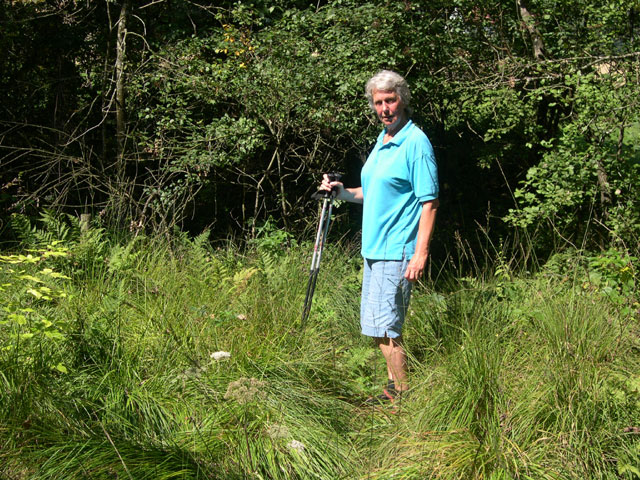
Back to the map and a rethink - in fact another map we got did not show this path and we read later in the paper in Bern that a young man walking home on a dark night had got stuck in a bog - up to his waist - and fortunately had his mobile phone with him.
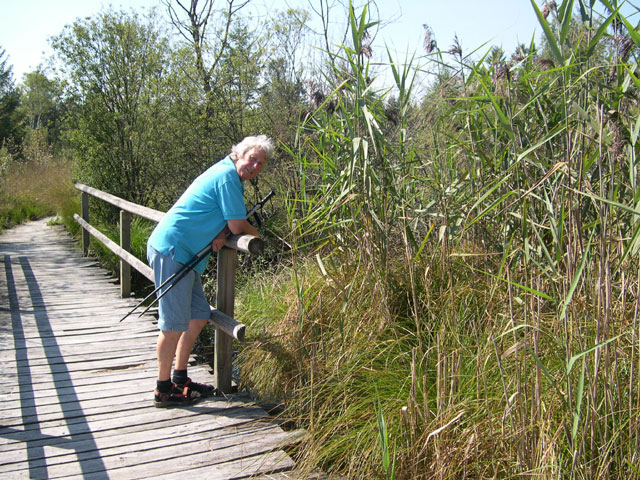

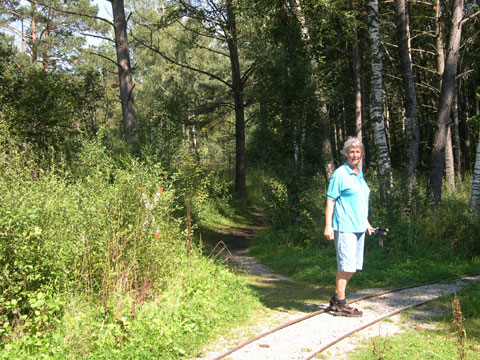
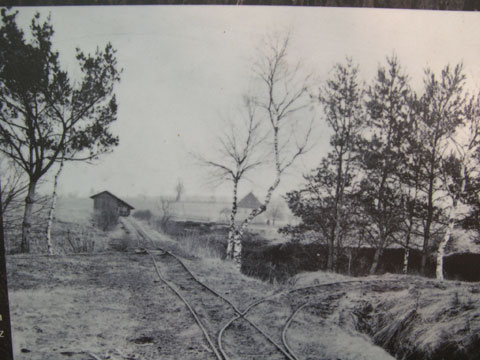

We went on round the north side of the bog and took the official path across the end bit where it was narrower and what a path it was - past stretches of heather and sometimes like a causeway between swamps and sometimes duck boards and later a series of boards explaining the peat exploitation and part of the old railway line out to the cuttings and one of the trucks - there was sure to be a pretty little town centre and we knew there was an old leper house and pilgrimage church , but when we got to the first square, guarded by huge statues of Mary and Joseph, we found a bus was due, the next would be in two hours, it was mid afternoon and hot and airless - two wind turbines had not been moving at all. The thought of getting back to Paradise for a shower and rest and a trip later to the old town in Bad Waldsee for a cup of tea before we did any culture was irresistible - and the bus was air conditioned. The talking pedometer said we'd done 16551 steps....
We did our culture after tea. A Muslim woman was sitting on a nearby bench taking the air and watching everything - I wonder what she was thinking. After tea I bought a straw sun visor and we visited the old twin-towered RC church with lots of gilding and carved pew ends and a stork dressed like a bishop outside. We also went past the castle (again like a huge country house) complete with a moat.
Then back to Paradise for supper - mine host decided what to give us: Spatzeli and Wiener Schnitzel and salad and then our beds were mercifully near - just the two flights of stairs. Hot weather is wonderful but it makes you tired.
Unterschwarzach to Ochsenhausen
The day's news from the Schwabische Zeitung was that a lot of pilgrims in Baghdad had been crushed to death in a panic on a bridge. Cows cannot get down from the Bavarian Alpine pastures because the paths were washed away in the rains.
We knew it would be a long day without much shade and one stretch later on was along a road - though the sun at least would be behind us - and the bus back for the 15 minute journey back to Unterschwarzach where we would begin the walk did not leave until 10.30 and we were carrying our rucksacks (not heavy) but there you go. Also according to our accommodation list there was a was one place with 'Fremdenzimmer' en route where we could stay if the heat and everything got too much. In the event there turned out to be two places. It was a pretty ride back to the beginning of the walk - everywhere looks so neat, prosperous and lush. Now we were out of its area, Hector had now got rid of his BODO bus and train timetable which, incidentally, had been so complicated it had taken even him time to suss it out.

The first part was through forest and then there was an inviting Biergarten at the village of Fueramoos with at least one person in it having a bier and reading the paper. We stood contemplating the tables and debated long as to whether to stop for a drink, decided we would and were walking towards a table when a voice floated up from behind the paper, 'Heute ist Ruhetag.' Never mind there was a tree and a bench round it on the other side of the village and a lovely breeze just past a row of pear trees with lots of windfalls where wasps and I first stocked up on Vitamin C.
There may have been tar, but no cars and wonderful wide views across rolling pastureland - perhaps the best views so far. There are crosses saying 'Gott segne unsere Flure'. Like Lorraine, it is ideal country for walking across rather than cosy little round walks. Our various hosts asked if we were on foot and showed no surprise - this path we are on evidently gets well used, not that we saw anyone.

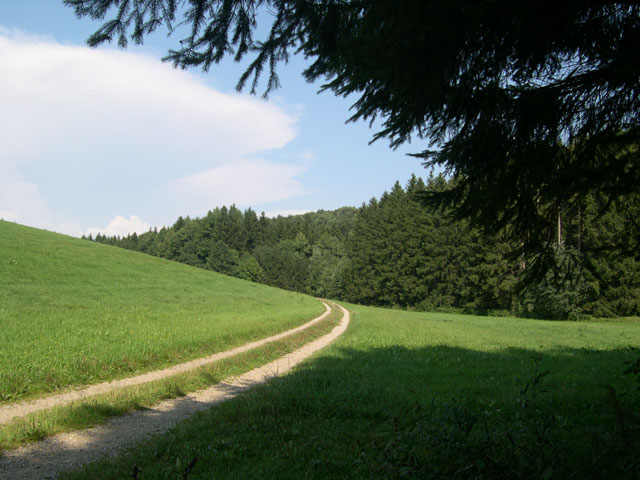
We stopped in a graveyard to fill up the water bottles. The best part of the walk to Ochsenhausen was the last 3 kms. The Monastery at Ochsenhausen was closed by Napoleon but before that the monks had found a spring 3 kms away bubbling out from under a rock and funnelled it to their House round the side of a wooded hill. It is called the Krummbach. The water tasted heavenly or we were hot and thirsty. The monks had used the shady path beside the channelled water to meditate and now it is, deservedly, a popular walk - and part of the HW4.

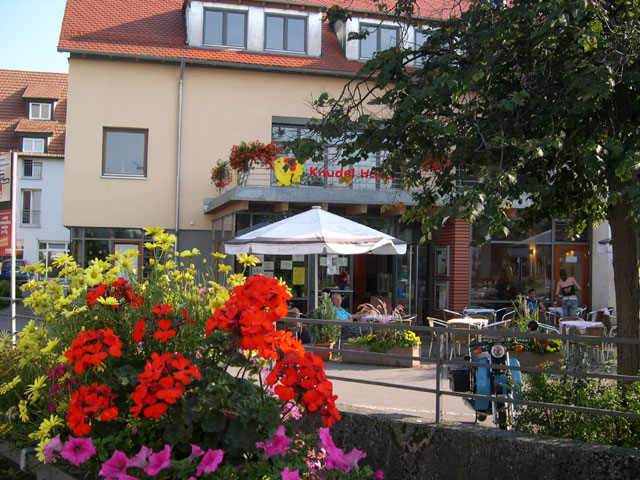
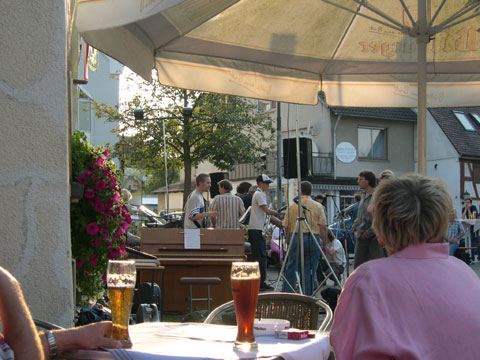

Our hotel was in the main square with lots of pretty flower boxes with a Knudel Kaff attached. Tables and benches and loudspeakers had been set up - the monastery is now the Landesakademie fur die Musizierende Jugend and as we ate our Kundels outside, we had a concert by the young students, mostly jazz, enthusiastically received by the families at the tables (like the folk programmes from Bavaria) and altogether charming. I had more than run out of energy and just sat but Hector went to explore after we'd checked in but did not find much of interest - even the monastery garden was not much. I meantime read the local paper and saw that there are indeed a couple of museums devoted to the Romans and Celts - though elsewhere and there is part of a Roman Road on the map - but not anywhere near where we were going and just a short stretch.
Had knudels for supper. The TV later was devoted to local politicking and New Orleans.
Ochsenhausen to Erolzheim 12 and a half kms. A third or less on tar. We are about 6-700 metres above sea level.
Mein host said goodbye, asked where we were going and said, when he saw my walking sticks, he hoped I wouldn't make Hector go too far. There were lovely views back to the monastery as we set off across more gently rolling countryside. An old lady asked what we were doing. I think she would have followed this up with the offer of a cup of tea but it was too early and it was best to make the most of the cooler beginning to the day. We had our first stop in an Indian camp (deserted) in the middle of the first long stretch of forest, later crossed the River Rot , went past two former mills and up a hill along another pointless stretch of EU tar and when not far from our goal came to tables and seats under a tree and a sign 'Hoeck a bitzle na' - so we did for a pleasant hour, nice countryside and silent except for a dog barking most of the time at the mill. But as always kites or buzzards mewing above us.
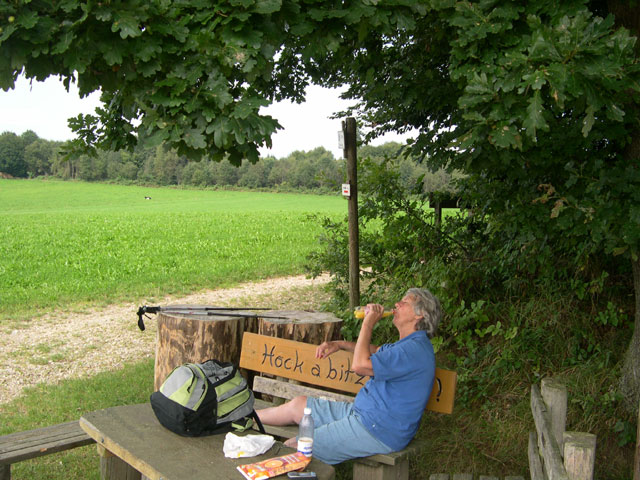
One feature of this walking is that it is all wide open spaces and no stiles (posh or delapidated) - which were the defeat of my mother in later years and spoil the rhythm of walking sometimes. It is superb pony and trap country. We were just about there when the path took us round and up a hill to a Chapel dedicated to Mary, an altarpiece carved in 1540 and a carving of May dying while the 12 stood round her rather like the Last Supper and many heraldic badges, one being a fish, three horizontal lines and a wine cup 'gracious living'?

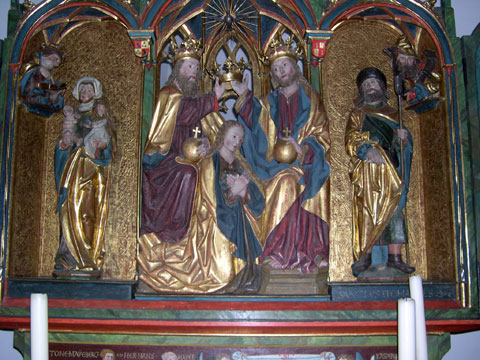


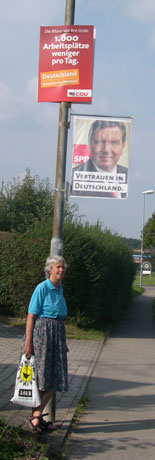 Best of all there was a magnificent view to the east of the River Iller (dead straight - quite unnatural) coming down from the Bavarian Alps to join the Danube at Ulm) and its enormous flood plain, now drained and intensively farmed.
It is the boundary with Bavaria - our path sometimes dipped into Bacvaria and we always knew that because people say Grüss Gott, not Guten Morgan.
Best of all there was a magnificent view to the east of the River Iller (dead straight - quite unnatural) coming down from the Bavarian Alps to join the Danube at Ulm) and its enormous flood plain, now drained and intensively farmed.
It is the boundary with Bavaria - our path sometimes dipped into Bacvaria and we always knew that because people say Grüss Gott, not Guten Morgan.
We went down steeply past the church - baroque - to the village where everyone seemed to be a sleep in the afternoon heat and rang the bell at the nearest Gasthof as instructed. A friendly woman came to the door and showed us to a sunny bedroom in the house behind looking up through trees at the church - I see a mosquito coil is provided for the night - where we could hear someone practising the organ. I think it was the elderly lady braving the trucks etc on the main road on her sit up and beg bicycle with her music in the basket. We went for a walk later but found little of interest other than what we'd seen except a bakery with a stand-up coffee bar), sat in the little square beside the hotel for a bit and then ate later in front of it.
The church clock struck the quarter hours in the night but never the hour - we asked our hosts at breakfast about this later. Apparently the clock was a law unto itself with the hours and had been known to strike 24 times and had therefore had that part of it silenced. When they found we would soon have walked to the edge of our map and hadn't managed to find the next, they copied a bit of map for us.
"What are you doing?" the woman in the bakery asked when we bought supplies. "Have a nice day!"
It was truly a walk in the woods - mostly firs - and good for one day and flattish easy walking along good forest tracks. We met one logging truck, some mushroom gatherers, one or two cyclists and passed many blackberries and belladonna and arrived in Dietheim down on the plain hot and tired as it was the p.mp - or I did, the heat doesn't bother Hector. The Gasthof we'd decided on was at the far end of the village past a monument to 'the fallen' of both World Wars and when we got there we found it was the first day of their annual hols. So back to the hotel . "Full," said madame, "like everywhere round here - there's a shepherds' congress in Ulm this weekend and a baby 'Messe' next - but let me think." - She looked at a hotel list and phoned Noah's Ark, a guest house just down the road and too small to be on our list and as it happened a mere 20 euros per night per head. (We heard later the hotel was very expensive.) Noah's Ark was actually a house with a flat at the top sleeping 4. One man from Saxony was there already but there was still a double room. Shower etc not en suite. Did we mind?? Ha Ha. Food store fifty yards away.

It was very pleasant even if Neanderthal man had the football on on the telly in the eating area and kept a saucepan full of cabbage on the stove all the time. He was quiet enough.
It was to be our day off but the one book in the flat was the bus and time table for this area and H had worked out we could do a half day, stay another night and tell Annabel and Gerry to join us. - they were en route to Croatia for a rally - because Neanderthal man, and hopefully his cabbage, .was going and there were two more beds.
Had a lazy morning brewing lots of cups of tea in the perfect little kitchen and took the one thirty bus to Illerrieden and walked back, first over two hills, one along the edge of an escarpment overlooking the Iller plain with extensive views had there been no trees. There was a lovely airy picnic place where we lingered until some plump wanderers came and picnicked with gusto at the next tables.

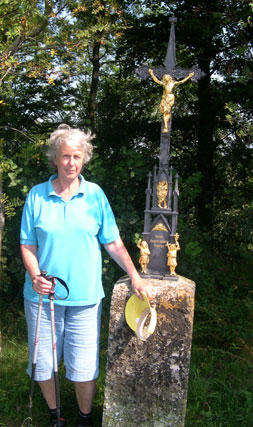
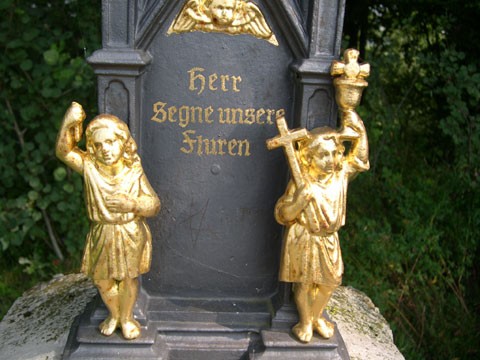
Then down beside the Iller which showed signs of having been badly flooded. There were a lot of info boards about the river and the fish therein. It is 147 kms from Oberstorf, source in the Alps, to where it joins Danube and was straightened in 1858 - 93 (The Correction) to make it flow faster and flood less - which explains why it looked so unnatural earlier. The kingdoms of Bavaria and Württemberg paid. 1924 - the canal was built for hydro-electricity. The water was a bit cloudy perhaps because of the flooding and the water less fast than the Aare.


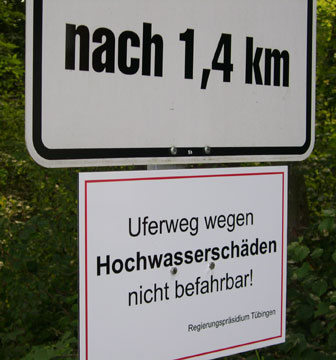
There were signs up saying the banks were not 'befahrbar' but any number of cyclists were using them it being a Sunday. There are two tracks so there is room for walkers and cyclists and indeed on both sides of the river. I had my swimming things because we should have come to a lake where you can swim but we missed it or it had been overwhelmed by the floods. We got back to find Neanderthal man and his cabbage concoction had set off for Saxony and everything beautifully shipshape for the four of us. A and G arrived at about 7.30 having come from home and topped us up with the various Xword puzzles etc in their Sunday Times. Knowing the food shop would be closed we'd already got in food. We thought we'd go for a pizza as we had the previous night but the place was so smoky and nowhere to eat outside that we got take-aways, had a drink outside while we waited and took them back to the flat. Madame said later she got a lot of cyclists and walkers staying and the hotel was very costly.

Hector managed to get the next map - the old edition - at the village shop.
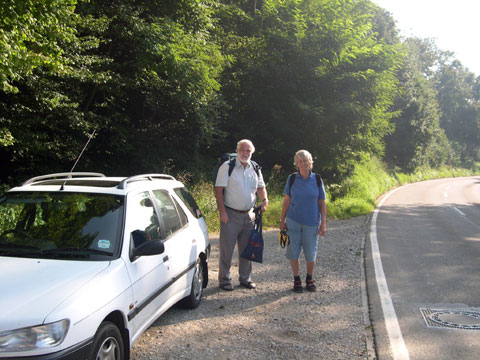

On a reasonable cool day reaching Ulm would have been possible but it was another hot day and we knew the nearer we got to Ulm the more buses there would be when we stopped off in a village. We are not town people but the thought of getting to a big place - and indeed a symbol of progress, was quite exciting.
It was another mixture of rolling farmland and woods plus one short stretch that hadn't been cut back at all. We rested on a bench where crows were all flying around saying 'Nevermore' and later saw a bird box with three holes the same size and two very flat bird boxes perhaps for the birds you find in Egyptian writing and later in an orchard a bird box on a pole high above an apple tree.

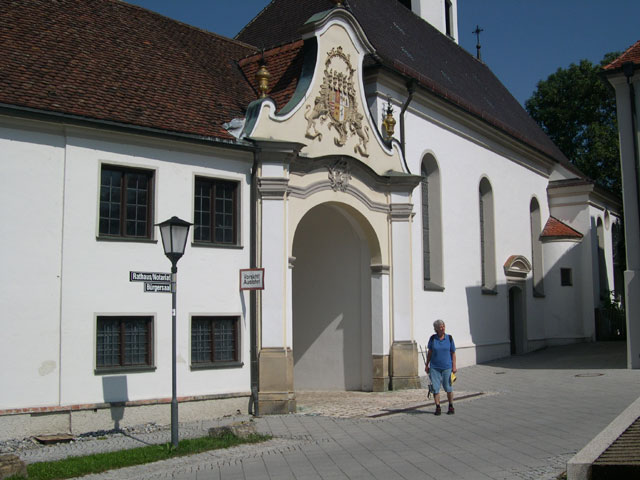
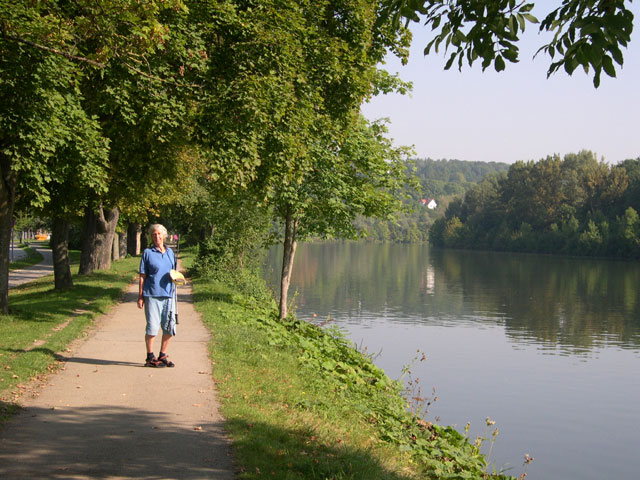
The Iller here looked so placid - some people drifted past in a boat. But bits of grass etc caught up in trees and the mud showed it had flooded to 3 or 4 metres above its usual level - the path being 2 metres above it. There were more notices warning people the path was not 'befahrbar' and indeed in places the top soil had been washed away leaving the underlying pebbles but clearly too a bulldozer had been along to clear the path - it is much used by cyclists.
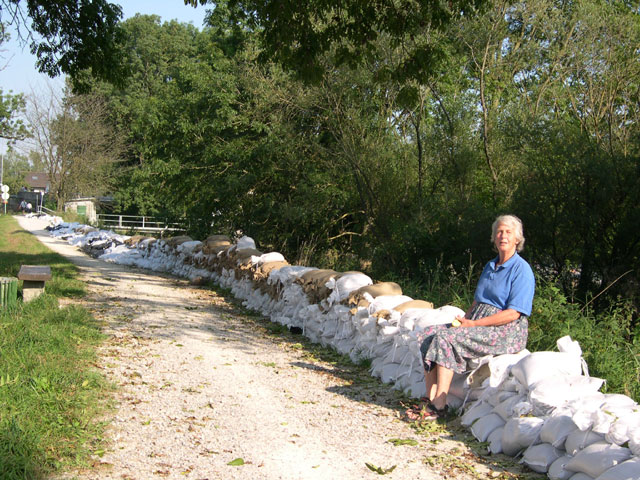
At 13.45 we cut up to the village of Wiblingen past a huge former monastery, came to a bus stop which said 'Kein einsteigen' and came to another just as a long bendy bus came past - wonderful! It deposited us at Ulm (university town and birthplace of Einstein) station where the bustling crowds came as a shock after 12 days of peace and first sight did not make the town look very attractive - we had barely yet seen the spire of the Munster, the tallest in Europe (Salisbury is second). Ulm is first mentioned in records in 854. Hector departed to look at the map and booked us into the Ibis - not quite the local colour we were used to, but just one bus stop away and very handy for everything, for three nights - wonderful to flop down on a bed!
We ate outside at a café just by the hotel and then in the balmy evening air walked down through the old town to the Danube. What an old town! So many interesting buildings plus two ultra modern ones and so quiet and traffic free. The Munster, partly brick, much scaffolding and dirty, has a huge area in front of it where people can just stroll or sit and have a drink - and it was once a car park - Just in front of the Munster there were chairs too to move around and sit on where we wanted - rather like a private garden. Any number of places to eat at.
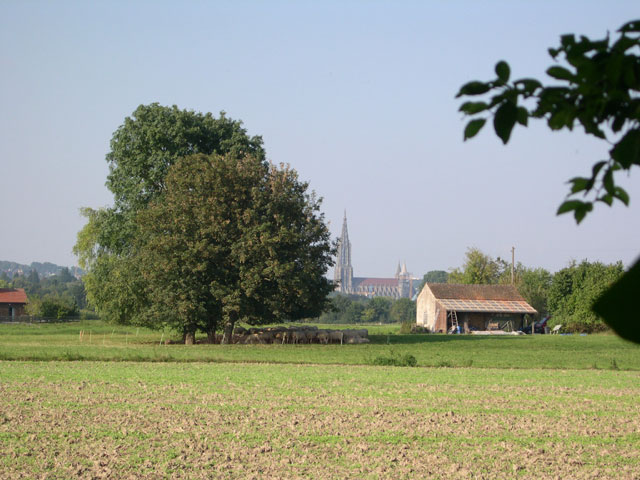

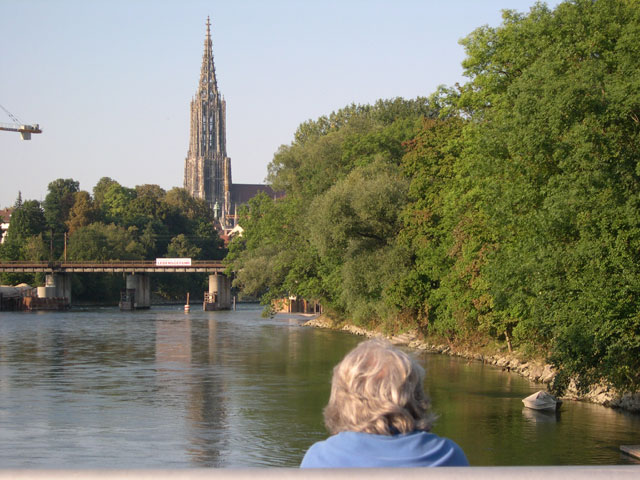
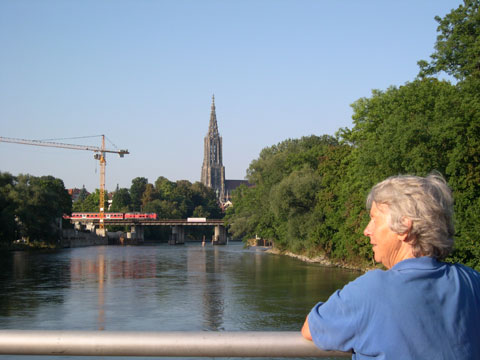
We did the rest of the river into Ulm the next day - we went round the inside of a huge bend where there were lots of shingle beaches. There was a splendid view of the Munster across the fields. We came to where the Iller flowed into the Donau, the Iller being the bigger and then were beside the Donau cycle way where the world and his wife went past. Dined in a courtyard by a mill leet and looking at a house that looked as if it was leaning so far it would collapse - one of the sights of Ulm and lots of Japanese etc came to look at it.

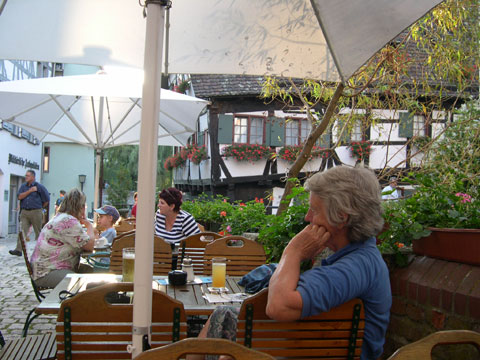
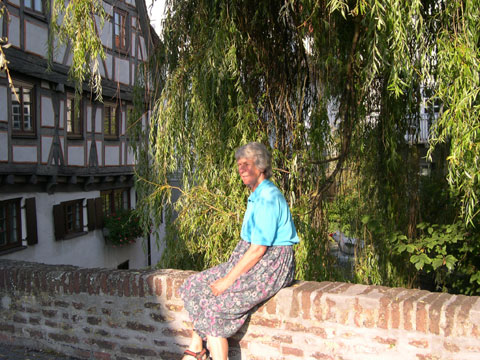

8 kms, one quarter tar.
To do the northern bit first, we took a tram to the end stop and walked through a park beside the Danube from there - the Danube showed no signs of having flooded - by now it is the Iller too but the Danube rises in the Black Forest where it hadn't rained. Ulm is well above the river so can't really flood.
The local bus and train area is DING = Donau-Illertal-Nahverkehrgesellschaft. And we had a day ticket because we wanted to do two bits of unrelated path, as it were.
The path we took through the woods had a feeling of being in the middle of nowhere. The land had once been owned by a monastery. Walked through the village of Thalfingen and up onto and across an airy plateau and another primeval wood providing most welcome shade. Then back down to the railway line with its two carriage trains. But a bus came first, we sat at the front and the driver regaled us with the daftness of the local fare structure.After the usual siesta, since we had a day ticket we went for a ride on a tram later out to the end of Ulm we hadn't seen - the poorer end. A girl got off with the most enormous ghetto blaster which she was trying to switch on as she got off and she and it nearly got cut in two by the door - oh to be young.

A pleasant feature of the landscape here is water towers capped with Chinese coolies' hats - making it all look a bit like northern Italy. The local paper said a new Prussian dictionary has just been printed - before all the old words get forgotten. There had been contributions from as far away as South America.
The forecast said light cloud cover so I didn't take my grasshopper sunshade. It was sunnier than ever and there were no woods and the white stones of the track glared up at us. We first walked back up through Elchingen and a young man stopped his car to let me cross the road. There was music pouring from it...a violin trio.
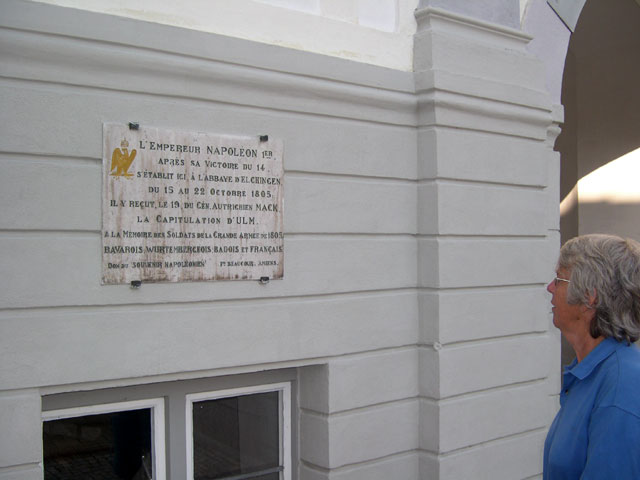
We stopped at the arch where Napoleon received the submission of Ulm after the battle of Elchingen in 1805 - it would be commemorated in 10 days time. There was a wonderful if hazy view to the south. We'd read somewhere that Germany is up to one third forest and this at this viewpoint we could believe. We walked along the top of the rise where the battle had taken place and there were more views to the north of mostly brown - not because of drought but pluffing in fact we passed a farmer doing just this and with those long furrows, it must have been boring work .This part of the path was the frontier between Bavaria and Württemberg, abolished when they became part of the German Empire in 1871.
The first place we came to was Langenau, cobbled and charming and with cabbages on sale shaped like huge turnips, then on to our journey's end under a very glaring sun and a very glaring path - darker tar might have been easier on the eyes . But there we could sit on a wall in the shade and - along came the bus.
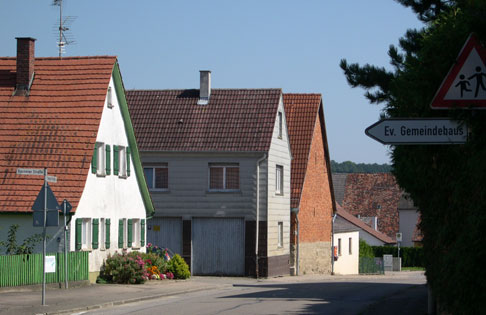
We were back in the old town of Ulm that evening visiting the Munster (Reformed) - very impressive and not too plain and exploring more little nooks and crannies - the old town grows on you. The Info Centre had an exhibition of what had been found outside the Munster when digging down and it also had a slide show about the history of the Munster and its surrounds and the bombing of Ulm 'under its murderous regime' in 1944 by the Brits and Americans - they missed the Munster.
I made the mistake of saying something loudly in English to Hector and thereafter the friendly young attendant spoke English - but that was the first time. Right to the end of this hol we heard no English voices (apart from Americans in the hotel. They were at some sort of trade congress). We met no fellow long distance walkers.
